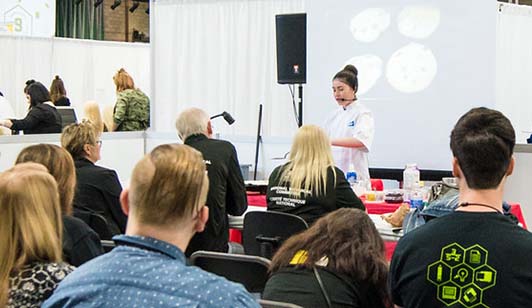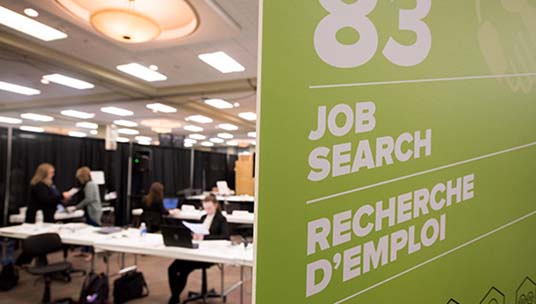Workplace Safety
What is workplace safety?
Inspectors in this unit group evaluate and monitor health and safety hazards and develop strategies to control risks in the workplace. They inspect restaurants, public facilities, industrial establishments, municipal water systems and other workplaces to ensure compliance with government regulations regarding sanitation, pollution control, the handling and storage of hazardous substances and workplace safety. They are employed throughout the private and public sectors.
Industrial related health and safety inspectors perform some or all of the following duties:
- Inspect the sanitary conditions of restaurants, hotels, schools, hospitals and other public facilities or institutions
- Conduct surveys and monitoring programs of the natural environment to identify sources of pollution
- Collect samples of water for analysis; measure physical, biological and chemical workplace hazards; and conduct safety and environmental audits
- Investigate health and safety related complaints, spills of hazardous chemicals, outbreaks of diseases or poisonings and workplace accidents
- nspect workplaces to ensure that equipment, materials and production processes do not present a safety or health hazard to employees or to the general public
- Develop, implement and evaluate health and safety programs and strategies
- Initiate enforcement procedures to fine or to close an establishment contravening municipal, provincial or federal regulations
- Provide consultation and deliver training programs to employers, employees and the general public on issues of public health, environmental protection or workplace safety.
- Examine plans, drawings, and site layouts for new buildings, building renovations and other proposed structures
- Inspect construction of buildings, bridges, dams, highways and other types of building and engineering construction for conformance to drawings, specifications, building codes or other applicable ordinances
- Inspect and test electrical or plumbing installations in buildings to ensure compliance with municipal, provincial and federal regulations Inspect steel framework, concrete forms, reinforcing steel mesh and rods, concrete or pre-stressed concrete to ensure quality standards and to verify conformance to specifications and building codes
- Inspect construction of sewer systems and pipelines
- Inspect construction sites to ensure that safe working conditions are maintained
- Inspect existing buildings to identify and report on structural defects, fire hazards and other threats to safety
- Inspect new or resale homes on behalf of clients and assess and provide reports on the physical condition of property
HOW TO JOIN THE FIELD
A bachelor’s degree or college diploma in a discipline such as food science, environmental studies, chemistry or health and safety is usually required.
In some establishments, several years of related work experience and the completion of in-house training courses may substitute for formal education.
Public health inspectors employed outside Quebec require certification with the Canadian Institute of Public Health Inspectors.
Occupational health and safety officers may require certification with the Association for Canadian Registered Safety Professionals.
For industrial related health officers, completion of secondary school is required. A college diploma in construction, civil engineering or architectural technology plus several years of related work experience or several years of experience as a qualified tradesperson in a construction trade, such as plumbing, carpentry or electrical trade are required. Provincial certification in a skilled trade or as an engineering technologist is usually required.
Leadership in Energy and Environmental Design (LEED) certification is offered by the Canada Green Building Council and may be required by some employers.
INDIGENOUS AND REMOTE CONSIDERATIONS
Indigenous and remote communities may have less access to safety protective resources and higher workplace safety hazards than other communities. This can be due to the remoteness itself, where inspectors and resources may not be located in communities and may need to travel or be sent in when needed. Further to this, there is often less access to emergency support and medical resources to respond when breaches of safety occur. As a result, more emphasis is needed on planning to deal with safety concerns using the available resources. There is also a need to build capacity within the communities to handle safety measures and respond to breaches to safety appropriately.
DISABILITY CONSIDERATIONS
People with disabilities sometimes face higher safety risks as a result of their disabilities. For example, if someone is in a wheelchair and there is a public safety risk such as a fire, plans need to be in place to quickly and safely get that individual out of a building. Employers and supervisors must work with their staff and public safety committees (where available) to ensure that everyone is included in emergency response plans, so that workers with disabilities can be properly accommodated. Likewise, employees with disabilities can bring this up with their supervisors and managers to ensure that suitable plans are in place to ensure their safety in an emergency situation.
Find the right career path for you with our interactive map!
Trouvez le cheminement de carrière qui vous convient grâce à notre carte interactive!
Sample Job Titles
- Health officer
- Health inspector
- Health and safety officer
- Occupational health and safety officer
- Public health inspector
- Water inspector
- Environmental health inspector
- Construction inspector
- Home inspector
Companies and Sectors
- Federal, provincial and municipal government
- Manufacturing plants
- Mining companies
- Construction companies
- Environmental agencies
- Self-employed (consultant)
- Housing companies
- Water inspection agencies

Workplace Safety and the Skills for Success Program
The key Skills for Success for this career path are:
- Communication
- Problem Solving
- Writing



